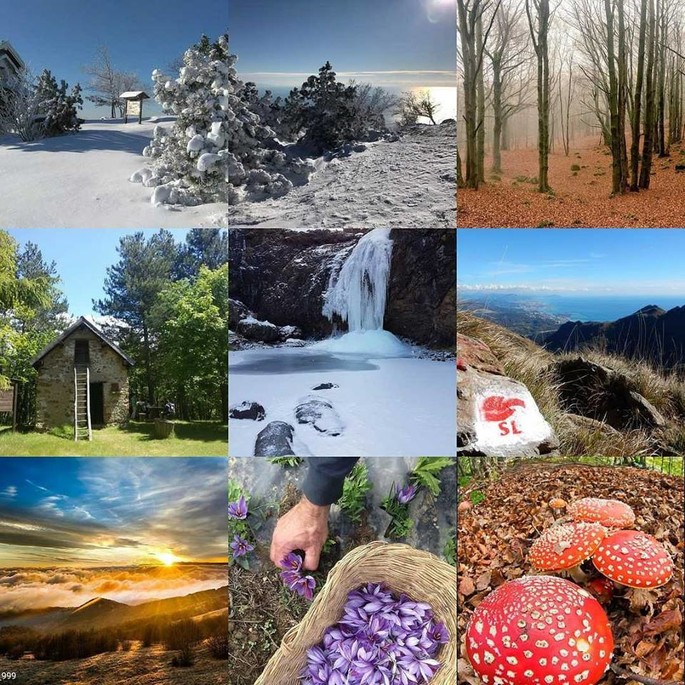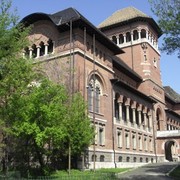A spectacular balcony formed by mountains facing the sea, where nature, history, culture, and ancient traditions are elements of extraordinary value and interest.
A Park to Safeguard Biodiversity
Twenty-six kilometers of mountain ridges which are situated very near to the Riviera Ligure and which develop from the Colle del Giovo to the Passo del Turchino parallel to the coast, passing for the summits of Mt. Beigua (1,287m), Cima Frattin (1,145m), Mt. Rama (1,148m), Mt. Argentea (1,082m), and Mt. Reixa (1,183m). They include grasslands and valuable wetlands, thick woods of beeches, English oaks, and chestnut trees, steep slopes and rocky outcrops, maritime pinewoods and belts of Mediterranean vegetation.
A mosaic of environments for which Beigua mountain group is considered one of the richest areas in biodiversity of Liguria: for this reason, in the Park 3 Sites of Community Importance have been proposed. The European Community, through the proposal of Regione Liguria and Ministero dell'Ambiente e della Tutela del Territorio, has further recognized the extraordinary naturalistic value of Parco del Beigua by establishing a Special Protection Area which is particularly important for migratory birds (the area is recognized as an "Important Bird Area" according to the classification of Bird Life International). The area is populated by over 80 nesting species, some of which of great value like the Golden Eagle, the Short-toed Eagle, the Rock Thrush, the Nightjar, and the Red-backed Shrike.
Along its most difficult routes which remain concealed to the sight of man, there is the wolf, and from the spurs facing the sea it is easy to see the silhouettes of the whales passing in front of Varazze, Cogoleto, and Arenzano.
In a few kilometers you can find an environmental variety which goes from the typical bloomings of the Mediterranean maquis to the high altitude peatbogs which are evidences of the past struggles of ice and rocks to shape the terrestrial surface.
A park where it is possible to find multicolored endemic floral species (Viola Bertolonii, Cerastium utriense, Asplenium cuneifolium, Daphne cneorum, Cheilantes marantae) and some animals belonging to the minor fauna (like the Montpellier snake, the Alpine newt, the crested newt, the common frog, etc.).
A park including three important Regional State Forests ("Deiva" in the Municipality of Sassello, "Lerone" in the Municipalities of Arenzano and Cogoleto, "Tiglieto" in the Municipalities of Tiglieto, Masone, and Campo Ligure) where the typical ungulates of the Ligurian Apennine live: among the others, wild boars, roe deer, and fallow deer.
Further information on the Park's environment, natural heritage and biodiversity are included in the Park management plan (in Italian).
Itineraries
The territory of the Park is crossed by a thick network of trails developing for about 500 km, giving the opportunity to appreciate its natural beauties and its historical - cultural features.
Going along the Park trails is like glancing through a wonderful book where tales of man and nature are told and represented.
In order to make the hikes throughout the protected areas more appealing, the Beigua Park has in some cases created equipped trails supported by panels and informative material which give visitors the opportunity to appreciate some of the naturalistic, historical, and cultural elements which can be seen along the way.
Within the protected area and in the surrounding territory there are accommodation structures, mountain huts and unattended shelters for long stays, in order to better appreciate the Park trail network.
Moreover, the Park Authority has prepared an efficient network of equipped green areas where you can stop and relax.
Details: www.parks.it/parco.beigua/Eiti.php
Beigua UNESCO Global Geopark
The Beigua district - the largest nature protected area in Liguria - preserves the geological history of the region, jealously portrayed through rocky outcrops, mineralizations, fossil deposits, spectacular forms modelled ceaselessly due to the effects of exogenous agents. Due to the exceptional geological heritage present in the Beigua district, in March 2005 a special international commission of experts positively assessed the dossier presented by the Beigua Park Authorities, thus awarding the territory the status of European and Global Geopark under the aegis of UNESCO. In November 2015, the same area has been recognized as UNESCO site and included in the prestigious list of the UNESCO Global Geoparks.
The Beigua Geopark includes the entire surface classified as the "Beigua Regional Nature Park" in addition to a vast portion of territory functionally linked with the park itself. Indeed, the Beigua Geopark represents a district made up of ten municipal territories (nine of which in their entire surface) involving two different provinces (Genoa and Savona). As a whole, the territory of the Beigua Geopark expands over 39,230 hectares, touching on the municipalities of Arenzano, Campo Ligure, Cogoleto, Genoa, Masone, Rossiglione, Sassello, Stella, Tiglieto, and Varazze.
Beigua Geopark is from a scientific, aesthetic and educational point of view one of the most interesting areas in Liguria and is extremely important with regard to reconstructing the geological history of Italy and to understanding the evolution of the Alpine Mountain chain and its relationship with the Apennines Mountains. The Geopark is a natural laboratory in which it is possible to interpret, from field data, the varying dynamics of the evolutionary phases in the development of the territory between Genoa and Savona.
The initiatives to conserve the geological heritage of the Beigua Geopark are included under the wider and complex strategy to safeguard the natural and historical/cultural heritage presented by the territory, pursued via planning and management measures aimed at achieving active protection of environmental resources, together with suitable and compatible socio-economical development, which obviously include activities linked to the conservation of its "geodiversity" and "geotourism".


























![Hanbury Gardens, itineraries for everyone all year round [Videos] Hanbury Gardens, itineraries for everyone all year round [Videos]](https://www.italyrivieralps.com/typo3temp/pics/g_a7708c6a79.jpg)





